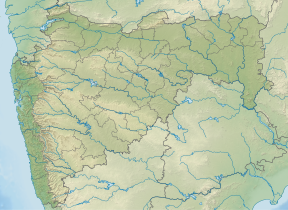Anjaneri
 From Wikipedia the free encyclopedia
From Wikipedia the free encyclopedia
| Anjaneri | |
|---|---|
 Anjineri fort Nasik | |
| Highest point | |
| Elevation | 1,280 m (4,200 ft) |
| Coordinates | 19°55′N 73°34′E / 19.92°N 73.57°E |
| Naming | |
| Native name | अंजनेरी किल्ला (Marathi) |
| Geography | |
| Location | Nashik, Maharashtra, India |
| Parent range | Trimbakeshwar |
| Geology | |
| Mountain type | hill fort |
Anjaneri, one of the forts in the mountain range of Nasik-Trimbakeshwa. Anjaneri is located 20 km away from Nasik by Trimbak Road. It is a popular trekking spot, especially in the rainy season.[1]
History[edit]

Anjaneri is an attraction of Nasik city, which is also an important fort in the Trimbakeshwar region. Situated at 4,264 feet (1,300 m) above sea level, it lies between Nasik and Trimbakeshwar near Godavari river. It neighbors the Brahmagiri range, significant in Hindu traditions as meditation spot of Sage Gautam. In some of the Puranas it is relayed that Hanuman's mother, Anjana Devi, was the daughter of Maharishi Gautama and Ahalya. When she refused to defend her mother against the accusation of adultery, she was cursed by Ahalya that she too would suffer shame by giving birth to a Vanara child before she was married. Anjana Devi, it is said, then resolved to undertake strict penance in the hills near her father's hermitage. Standing on one leg, she became so absorbed in meditation that an anthill is supposed to have grown around her. Due to the intensity of her tapas, Indra's throne began to shake and the gods were disturbed by the strong energies that were released. Sage Narada was dispatched to seek Shiva's help in containing these energies who then incarnated as her son Hanuman.[2]
The Brahma Purana while extolling the greatness of the Godavari and the pilgrimage places along its course, narrates that a celestial nymph named Anjana mocked Indra for having a thousand eyes and she was cursed to be born on earth with a monkey face. Her friend, Adrika, also annoyed Indra by meowing like a cat and was cursed to be born as a human being with the face of a cat. Both the nymphs were born among the Vanaras and were later married to Kesari, the king of Anjaneri's Vanara Kingdom. When Sage Agastya took up residence in this forest, Anjana and her friend Adrika served him with great devotion and he granted them each the boon of having an illustrious son. While walking in the forest one day, Anjana attracted the wind god Vayu and Adrika attracted Nirṛti. In due course, Anjana gave birth to Hanuman and her friend to Adri. When their sons grew older, their divine fathers advised them to take their mothers on pilgrimage to the Godavari River. Anjana bathed at a sacred place called Anjana tirtha, while Adrika took a bath at Marjari tirtha, obtaining release from Indra's curse and regained their heavenly forms.[3]
Anjaneri is the birthplace of Lord Hanuman, and is named after Lord Hanuman's mother, Anjani. The Bhavartha Ramayana of the famous Marathi saint-poet Eknath, states that Anjana Devi, intent on obtaining an exemplary son, performed severe austerities on top of the Anjaneri Hill for 7,000 years, with Shiva granting her boon by incarnating as her as son in the form of Hanuman.[4]
108 Jain caves are found here belonging to the 11th-12th century.[5] This place was used by Raghunathrao Peshwa as summer retreat when he as in exile. During British Raj, the Christian missionaries of Saharanpur and Malegaon regularly visited Anjaneri during summer and held the service of the Church of England.[6]
Anjaneri is declared as Conservation Reserve in 2017 under the section 36A of WildLife protection Act, 1972, The area of conservation reserve is 5.69Sq.km.[7]
References[edit]
- ^ Sheikh, Azhar (30 March 2018). "जाणून घेऊया : हनुमान जन्मस्थळाने परिचित नाशिकमधील चार हजार फूटी अंजनेरी गड". Lokmat (in Marathi). Retrieved 1 June 2022.
- ^ Kamandalu the Seven Sacred Rivers of Hinduism by Shrikala Warrier, pg. 170-171 [1]
- ^ Kamandalu the Seven Sacred Rivers of Hinduism by Shrikala Warrier, pg. 172 [2]
- ^ Kamandalu the Seven Sacred Rivers of Hinduism by Shrikala Warrier, pg. 172 [3]
- ^ Titze & Bruhn 1998, p. 78.
- ^ Pathak, Srunchandra S. (1975). Nashik District gazetteer (second ed.). Bombay: Government of maharashtra. Retrieved 21 May 2021.
- ^ Govt of India. "Conservation Reserves". ENVIS Centre on Wildlife & Protected Areas. Ministry of Environment and Forests. Retrieved 20 May 2021.
- Titze, Kurt; Bruhn, Klaus (1998), Jainism: A Pictorial Guide to the Religion of Non-Violence (2 ed.), Motilal Banarsidass, ISBN 81-208-1534-3
